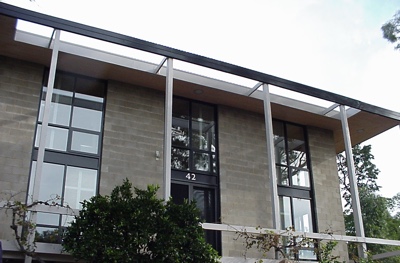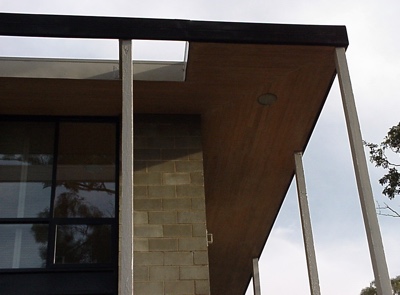42, 44 and 46 Vasey Crescent, Campbell (1960)

42 Vasey Crescent
42, 44 and 46 Vasey Crescent, Campbell were designed by Roy Grounds of the firm Grounds, Romberg and Boyd in 1960. As a result of a collaboration between the owners of each block, the three houses were designed by the same architect and built as a coordinated group. When Grounds received the commission to design the Victorian Arts Centre, management of the Vasey Crescent group of houses was taken over by Robin Boyd.
The houses are fine examples of the post-war Melbourne regional style with their long unbroken rooflines and widely projecting eaves. With their strong formal composition, large areas of glazing and open plan living areas, the houses also exhibit aspects of the post-war international style. Note the similarities with other work by Grounds in Canberra: Forrest Townhouses (1959) and 24 Cobby Street, Campbell (1963–64).
Significance
The Vasey Crescent houses are listed on the ACT Chapter of the Australian Institute of Architects (AIA) Register of Significant Twentieth Century Architecture. They are regarded by the AIA as being an important example of the post-war Melbourne regional style.
The Vasey Crescent houses are a rare Canberra example of owners collaborating to achieve a group of houses with consistency of form, style and materials on adjacent blocks. In 1998 the ACT Chapter of the Australian Institute of Architects (AIA) awarded the Vasey Crescent houses one of its coveted 25 Year Awards.
Description
The site for the Vasey Crescent houses is on an east-west ridge running from Russell Hill, with a fall to the street. Each house has a northern aspect but through staggered siting, each house has western views over the city. Number 46 is sited closest to the road; 42 the furthest.

Eaves detail: 42 Vasey Crescent
The houses are designed on three levels, with the ground floor of each at the same level. All have Besser concrete block walls, timber framed fenestration panels, flat roofs with metal decking and overhanging eaves and strong rectilinear forms. Two of the three houses are substantially original.
42 Vasey Crescent
The first level consists of a garage, studio and store. Level two has an external balcony running the full width of the house and along the western facade, with the entry hallway a central zone with stairway. This level originally contained three bedrooms, a laundry and a bathroom. On level three the staircase opens to an open plan reception, living and dining area; this level also contains the main kitchen and master bedroom.
44 Vasey Crescent
Unfortunately, number 44 has been extended on three occasions (1973, 1976 and 1990). The original house consisted of a garage and storeroom on the lower level. An external staircase led to the entry on the second level, which contained large living and dining areas, playroom and kitchen with full width glazing looking out to the west. The third level contained three bedrooms, a study and bathroom.
46 Vasey Crescent
On the lower floor is a garage and storeroom. The second level entry is planned as a rectangular wing on a north-south axis. External stairs lead up to the entrance, opening to entry hall, dining, kitchen and living room facing north, the full width of the wing. The main bedroom and ensuite are also at this level. Stairs lead up to the third level, planned as a children’s wing, with a central playroom, four small bedrooms and a bathroom.
Source
- Australian Institute of Architects RSTCA Citation No. R57